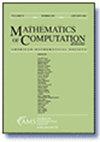简单网格下有限体积元素方法的多项式保留恢复
IF 2.1
2区 数学
Q1 MATHEMATICS, APPLIED
引用次数: 0
摘要
利用多项式保留恢复法(PPR)为有限体积元素法(FVEM)构建了简网格下的梯度恢复。本文的主要成果有两个方面。首先,我们研究了有限体积元素法的超粘性,特别是研究了四面体网格下的二次元有限体积元素法。其次,我们提出了几条选择计算节点的准则,从而使 PPR 的最小二乘拟合过程获得唯一解。数值实验证明,PPR 所恢复的梯度具有超收敛性。本文章由计算机程序翻译,如有差异,请以英文原文为准。
Polynomial preserving recovery for the finite volume element methods under simplex meshes
The recovered gradient, using the polynomial preserving recovery (PPR), is constructed for the finite volume element method (FVEM) under simplex meshes. Regarding the main results of this paper, there are two aspects. Firstly, we investigate the supercloseness property of the FVEM, specifically examining the quadratic FVEM under tetrahedral meshes. Secondly, we present several guidelines for selecting computing nodes such that the least-squares fitting procedure of the PPR admits a unique solution. Numerical experiments demonstrate that the recovered gradient by the PPR exhibits superconvergence.
求助全文
通过发布文献求助,成功后即可免费获取论文全文。
去求助
来源期刊

Mathematics of Computation
数学-应用数学
CiteScore
3.90
自引率
5.00%
发文量
55
审稿时长
7.0 months
期刊介绍:
All articles submitted to this journal are peer-reviewed. The AMS has a single blind peer-review process in which the reviewers know who the authors of the manuscript are, but the authors do not have access to the information on who the peer reviewers are.
This journal is devoted to research articles of the highest quality in computational mathematics. Areas covered include numerical analysis, computational discrete mathematics, including number theory, algebra and combinatorics, and related fields such as stochastic numerical methods. Articles must be of significant computational interest and contain original and substantial mathematical analysis or development of computational methodology.
 求助内容:
求助内容: 应助结果提醒方式:
应助结果提醒方式:


